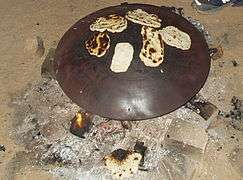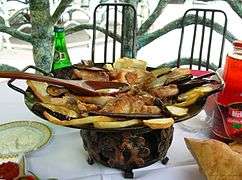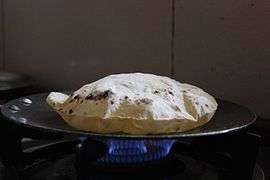Tava
A tava(h), tawa(h), tapa, saj, or saj tava is a flat or concave disc-shaped frying pan or griddle, usually made of cast iron, aluminum, or carbon steel.[1] It may be enameled or given a non-stick surface.[2][3] It is used in the cuisines of Central, West, and South Asia, and of the Caucasus, the Caribbean, and the Balkans. The large concave styles of tava, sometimes called a saj or sac tava, may be turned upside down for cooking a variety of flatbreads on the convex side. The concave side is used like a wok[4] or frying pan.[5][6]
Etymology
In nearly all Indo-Aryan languages such as Punjabi, Hindi and Urdu tawaa means cooking pan.[7] It is cognate with the Persian word tāve (تاوه),[8] which is used in Iran, and with the Georgian tapa (ტაფა); while the name saj ((صاج) in Arabic, lit. sheet-metal)[9][10] and written saç or sac in Turkish is used in Southwest Asia, with overlap in Pakistan and Afghanistan.[11] The word tava is also used in Bosnian, Croatian, Serbian, Romanian and Turkish and refers to any kind of frying pan. In Serbia and Bulgaria, flat ceramic сач or сачѐ (sach/sache) are used for table-top cooking of thin slices of vegetables and meat; тава (tava), on the other hand, are metal baking dishes with sides. In Pashto it is more popularly known as Tabakhey (تبخے/طبخی).
 Pita being baked on a convex saj
Pita being baked on a convex saj Reversible Azerbaijani sadj with handles
Reversible Azerbaijani sadj with handles
Uses
A tava or saj is used to bake a variety of leavened and unleavened flatbreads and pancakes across the broad region: pita, naan, saj bread, roti, chapati, paratha, dosa, and pesarattu. In Pakistan, especially in rural areas, large convex saj are used to cook several breads at a same time or to make rumali roti.
- A Palestinian woman baking markook on a saj in a West Bank village
 A roti being baked on a tava
A roti being baked on a tava.jpg) Gözleme, a filled bread, being baked on a sac
Gözleme, a filled bread, being baked on a sac Manasir woman preparing qurasah (قراصة), the daily bread on Sherari Island in Dar al-Manasir in Northern Sudan
Manasir woman preparing qurasah (قراصة), the daily bread on Sherari Island in Dar al-Manasir in Northern Sudan
 Vegetables fried in a tawa
Vegetables fried in a tawa Aloo chaat being cooked in a large tava
Aloo chaat being cooked in a large tava- Fish frying in a tawa
See also
- Comal (cookware), a similar utensil in Mexican cuisine
- Mittad
- Mongolian barbecue, a Taiwanese grill dish sometimes using a saj-like frying pan.
- Sač, a cooking utensil used in the Balkans with a saj-shaped lid
- List of cooking vessels
References
- Petrina Verma Sarkar, "What Is an Indian Tawa?", The Spruce Eats April 13, 2019
- Marie Simmons, Things Cooks Love: Implements, Ingredients, Recipes, 2008, ISBN 0740769766, p. 251
- https://www.google.com/books/edition/South_Indian_Cooking/3m6DBAAAQBAJ?hl=en&gbpv=1&dq=tava+non+stick&pg=PT32
- https://www.google.com/books/edition/Fodor_s_Turkey/FEVEAgAAQBAJ?hl=en&gbpv=1&dq=sac+tava+wok&pg=PT751
- Mason, Taymer (2016-11-29). Caribbean Vegan: Meat-Free, Egg-Free, Dairy-Free Authentic Island Cuisine for Every Occasion. The Experiment. ISBN 9781615193615.
- "How Do You Use a Tawa to Cook Indian?". The Spruce Eats. Retrieved 2019-10-02.
- "A dictionary of Urdu, classical Hindi, and English". Dsalsrv02.uchicago.edu. Retrieved 2017-10-11.
- F. Steingass, A Comprehensive Persian-English Dictionary, 1930, p.277
- Maxime Rodinson, et al., Medieval Arab cookery, 2001, p. 154
- Hans Wehr, Dictionary of Modern Written Arabic, 1966, p.499
- Suad Joseph, Afsaneh Najmabadi, Encyclopedia of Women & Islamic Cultures: Family, body, sexuality and health, 2005, p. 109
Sources
- "Your Desi (Indian) Kitchen on the Net". Archived from the original on 2008-04-08. Retrieved 2008-04-01.
- "Pots, Pans, and Griddles". Archived from the original on 2008-10-14. Retrieved 2008-05-01.
- "A Fork on the Road". - Miami Herald online. Retrieved February 21, 2008.
- "Saj Femmes". Blog: Land and People. 2007-09-23. Retrieved February 21, 2008.